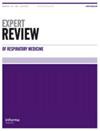Predicting the successful application of high-flow nasal oxygen cannula in patients with COVID-19 respiratory failure: a retrospective analysis.
IF 0.9
3区 医学
Q2 RESPIRATORY SYSTEM
引用次数: 0
Abstract
ABSTRACT Background The right time of high-flow nasal cannulas (HFNCs) application in COVID-19 patients with acute respiratory failure remains uncertain. Research design and methods In this retrospective study, COVID-19-infected adult patients with hypoxemic respiratory failure were enrolled. Their baseline epidemiological data and respiratory failure related parameters, including the Ventilation in COVID-19 Estimation (VICE), and the ratio of oxygen saturation (ROX index), were recorded. The primary outcome measured was the 28-day mortality. Results A total of 69 patients were enrolled. Fifty-four (78%) patients who intubated and received invasive mechanical ventilatory (MV) support on day 1 were enrolled in the MV group. The remaining fifteen (22%) patients received HFNC initially (HFNC group), in which, ten (66%) patients were not intubated during hospitalization were belong to HFNC-success group and five (33%) of these patients were intubated later due to disease progression were attributed to HFNC-failure group. Compared with those in the MV group, those in the HFNC group had a lower mortality rate (6.7% vs. 40.7%, p = 0.0138). There were no differences in baseline characteristics among the two groups; however, the HFNC group had a lower VICE score (0.105 [0.049–0.269] vs. 0.260 [0.126–0.693], p = 0.0092) and higher ROX index (5.3 [5.1–10.7] vs. 4.3 [3.9–4.9], p = 0.0007) than the MV group. The ROX index was higher in the HFNC success group immediately before (p = 0.0136) and up to 12 hours of HFNC therapy than in the HFNC failure group. Conclusions Early intubation may be considered in patients with a higher VICE score or a lower ROX index. The ROX score during HFNCs use can provide an early warning sign of treatment failure. Further investigations are warranted to confirm these results. Plain Language Summary High flow nasal cannulas (HFNCs) were widely used in patients with COVID-19 infection related hypoxemic respiratory failure. However, there were concerns about its failure and related delayed intubation may be associated with a higher mortality rate. This retrospective study revealed patients with higher baseline disease severity and higher VICE scores may be treated with primary invasive mechanical ventilation. On the contrary, if their baseline VICE score is low and ROX index is high, HFNCs treatment might be safely applied initially. The trends of serial ROX index values during HFNC use could be a reliable periscope to predict the HFNC therapy outcome, therefore avoided delayed intubation.预测高流量鼻吸氧插管在COVID-19呼吸衰竭患者中的成功应用:回顾性分析
背景:新冠肺炎合并急性呼吸衰竭患者应用高流量鼻插管的时机尚不确定。研究设计与方法:本研究以低氧性呼吸衰竭的covid -19感染成人患者为研究对象。记录患者的基线流行病学资料和呼吸衰竭相关参数,包括COVID-19通气率(VICE)和血氧饱和度(ROX指数)。测量的主要结果是28天死亡率。结果:共纳入69例患者。54例(78%)患者在第1天插管并接受有创机械通气(MV)支持,被纳入MV组。其余15例(22%)患者最初接受HFNC (HFNC组),其中10例(66%)患者住院期间未插管,属于HFNC成功组,其中5例(33%)患者因疾病进展后插管,属于HFNC失败组。HFNC组死亡率较MV组低(6.7% vs. 40.7%, p = 0.0138)。两组患者的基线特征无差异;而HFNC组的VICE评分(0.105[0.049-0.269]比0.260 [0.126-0.693],p = 0.0092)低于MV组,ROX指数(5.3[5.1-10.7]比4.3 [3.9-4.9],p = 0.0007)高于MV组。HFNC治疗成功组的ROX指数在治疗前(p = 0.0136)和治疗12小时时均高于HFNC治疗失败组。结论:对于VICE评分较高或ROX指数较低的患者,可考虑早期插管。hfnc使用期间的ROX评分可以提供治疗失败的早期预警信号。有必要进一步调查以证实这些结果。
本文章由计算机程序翻译,如有差异,请以英文原文为准。
求助全文
约1分钟内获得全文
求助全文
来源期刊

Expert Review of Respiratory Medicine
RESPIRATORY SYSTEM-
CiteScore
6.80
自引率
2.60%
发文量
90
期刊介绍:
Coverage will include the following key areas:
- Prospects for new and emerging therapeutics
- Epidemiology of disease
- Preventive strategies
- All aspects of COPD, from patient self-management to systemic effects of the disease and comorbidities
- Improved diagnostic methods, including imaging techniques, biomarkers and physiological tests.
- Advances in the treatment of respiratory infections and drug resistance issues
- Occupational and environmental factors
- Progress in smoking intervention and cessation methods
- Disease and treatment issues for defined populations, such as children and the elderly
- Respiratory intensive and critical care
- Updates on the status and advances of specific disease areas, including asthma, HIV/AIDS-related disease, cystic fibrosis, COPD and sleep-disordered breathing morbidity
 求助内容:
求助内容: 应助结果提醒方式:
应助结果提醒方式:


